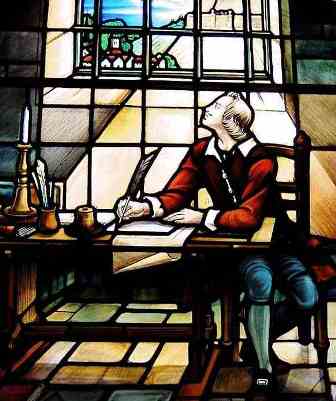CHURCH & MINISTRY
An Unfamiliar Pastor
By Dolores Kimball

Bunyan goes on to explain the meaning of the man's attributes. His eyes being lifted to Heaven, the Book and the Law of Truth "are meant to show you that his work is to know and reveal to sinners things hard to understand." The world being behind him and the crown describe a man "who is slighting and despising the things that are present because he loves the work given to him by his Master." He goes on to say that the man in the portrait is "the only one authorized by the Lord — to be your guide in all the difficult places you may encounter within the Way." He ends with the warning to think seriously about the portrait lest he meet those "who pretend to lead you correctly, but whose ways lead to death."
As I said, no one recognized the portrait as a pastor. Some thought it was the Apostle Paul, others thought a good teacher and still others, a "spiritual person." Why, I wondered, did not one person see in this description a portrait of their, or anyone's, pastor? Would I have recognized it if I hadn't read the commentaries in preparation to teach the lesson? Pondering these questions has led to the inevitable conclusion that modern pastors differ widely from those in Bunyan's day, partly because the church differs widely from churches of that era. Part of this is due, no doubt, to the advent of technology and the modern way of life in general. The church is no longer a small group of believing friends and neighbors gathering together for worship and edification. The church in America is more a corporate entity with the pastor as CEO and the elders/deacons performing the functions of middle management.
The modern pastor's portrait is a far cry from the one in the Interpreter's house. If a portrait was painted today, the description might run more along these lines: "The man has eyes focused down upon the world, so that he can glean from it the most effective sales and management methods. The Best of Books (Church Growth 101 and How to Plan Your Church Budget) were in his hand. The Law of Truth was written upon his mind in seminary, but it was mixed with so many different interpretations of men that he's never really had a sure conviction of its meaning. He'd like the world to be behind his back, but since he spends more time on his computer than in the Book, the world has more influence on him than even he realizes. He'd like to plead with men for their souls, but the hard truths of sin, judgment and hell are considered too divisive. After all, if he preaches to ‘sinners things hard to understand,' he might lose half his congregation and then where would his budget be? A crown of gold may hang over his head, but he is so obsessed with numbers and the fulfilling of his vision that he hardly gives it a thought."
I can't help but wonder how many of today's pastors are not the pastor Bunyan describes, but those "flatterers" Bunyan warns us about — those who pretend to lead us correctly, but whose ways lead to death. May we all, both pastors and congregations, heed a warning from 1678 and pray for wisdom and discernment, both for our leaders and for those they lead.
Image: Stained glass window of John Bunyan; The John Bunyan Museum, Bedford, England
comments powered by Disqus
Published 4-25-12

